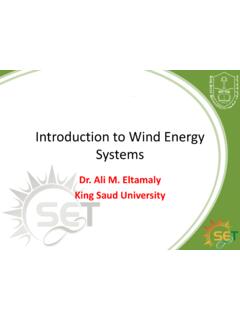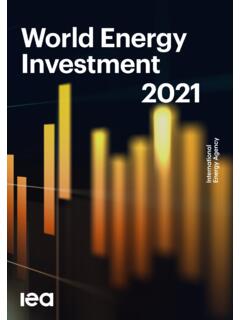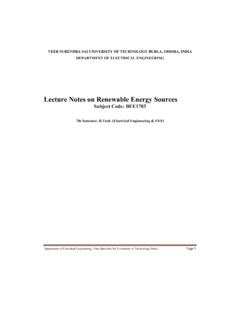Transcription of Introduction to Solar Energy Technologies - KSU
1 Introduction to Solar Energy Technologies Dr. Syed Noman Danish Assistant Professor Outline Importance of Renewable Energy Technologies KSA Renewable Energy Plan 2012-2032 Solar Energy Solar Energy Technologies Concentrated Solar Power (CSP) Solar PV Solar Water Heating System Energy demand and emissions have doubled in the past 40 years From 6,000 Mtoe to 12,000 Mtoe Rapid demand growth outside OECD Source: IEA statistics CO2 emissions from 14Gt to 30Gt Since 2005, non-OECD countries emit more than OECD Importance of Renewable Energy Technologies Energy TECHNOLOGY PERSPECTIVES 2012 American Petroleum Institute estimates that we will consume all world oil within 40 years International Panel on Climate Change (IPCC)
2 Estimates, global average sea level will rise by 2 feet in next century OECD/IEA 2012 6DS where the world is now heading, with potentially devastating results The 6 C Scenario 4DS reflecting pledges by countries to cut emissions and boost Energy efficiency The 4 C Scenario 2DS a vision of a sustainable Energy system of reduced CO2 and other Greenhouse Gas (GHG) emissions The 2 C Scenario Source: IEA statistics Importance of Renewable Energy Technologies Energy TECHNOLOGY PERSPECTIVES 2012 Choice of 3 Futures (2050) Source: IEA statistics To achieve ambitious climate goals, the world needs to cut Energy -related CO2 emissions by 50% from today s.
3 But as populations grow and Energy consumption inevitably rises, the reduction challenge is even higher: a gap of 24-42 Gt in 2050 Need to Halve CO2 by 2050 Importance of Renewable Energy Technologies Energy TECHNOLOGY PERSPECTIVES 2012 KSA Renewable Energy Plan 2012-2032 $109b for 41GW of Solar capacity (30% of KSA s total electricity demand in 2032) Saving 523k barrels of oil per day by 2032 Extra 21GW (Nuclear, Wind, and Geothermal) PV and 900MW CSP are planned to be completed in 2013 Source: SET Report 2013: Status of Renewable Energy in Saudi Arabia Solar Energy Earth receives 174 PW (only trillionth of total Solar Energy ) 30% is reflected back to space while the rest is absorbed by clouds, oceans and land masses.
4 In one hour the earth receives more Energy from the sun than the world consume in one year. If a 33 x 33 km parcel of land (1112 km2 out of 2,217,949 km2) was covered with Solar collectors, the electricity needs of the entire KSA could be met! Yearly Solar fluxes & Human Energy Consumption in 2009 (EJ) Solar 3,850,000 Wind 2,250 Biomass potential 100 300 Pri. Energy use 510 Electricity Solar Energy Potential Potential of the different renewable Technologies . Source: Solar Energy Potential in KSA Power production in Saudi Arabia (2010) = 219 TWh Considering average yearly irradiance of kWh/m2 year So for 1 km2 of land, Total Available Energy = GWh/year To avoid shadowing, Solar collectors can not cover all surface; assuming a land occupation factor of 50% 2500 GWh x 0,5 = GWh Avg.
5 Total efficiency in annual Solar Energy collection (parabolic troughs): 45% 562,5 GWh Rankine cycle efficiency: 35% 197 GWh 219,000 / 197 = 1112 km2 required square of 33 km side length Saudi Arabia land surface: 2,217,949 km Solar Energy Concentrated Solar Power (CSP) Parabolic Trough Solar Thermal System Central Tower Solar Thermal System Linear Fresnel Solar Thermal System Parabolic Dish Solar Thermal System KSU Indigenous CSP Systems Concentrated Solar Power (CSP) How does a coal or oil power generation system work? Concentrated Solar Power (CSP) Schematic diagram of a Solar -thermal Energy conversion system.
6 How does a CSP power station work? Concentrated Solar Power (CSP) Parabolic Trough Solar Thermal System Central Tower Solar Thermal System Linear Fresnel Solar Thermal System Parabolic Dish Solar Thermal System KSU Indigenous CSP Systems Concentrated Solar Power (CSP) 1. Parabolic Trough Solar Thermal System The most mature existing CSP About 35 years of commercial experience The troughs concentrate sunlight onto a receiver tube that is positioned along the focal line of the trough. Sometimes a transparent glass tube envelops the receiver tube to reduce heat loss Temperatures at the receiver can reach 400 C Concentrated Solar Power (CSP) ONE-AXIS PARABOLIC TROUGH COLLECTOR 1.
7 Parabolic Trough Solar Thermal System Concentrated Solar Power (CSP) FIRST APPLICATION OF MODERN ERA 1. Parabolic Trough Solar Thermal System Concentrated Solar Power (CSP) SEGS IN CALIFORNIA 1. Parabolic Trough Solar Thermal System 354 MW largest CSP facility in the world. 9 plants power 232,500 homes displace 3,800 tons of pollution per year 936,384 mirrors Land Use: 70 MW/km2. 1,600 acres extend over 369 km LEC ~$ kWh Aerial view showing portions of four of the nine SEGS III VII plants Concentrated Solar Power (CSP) Parabolic Trough Solar Thermal System Central Tower Solar Thermal System Linear Fresnel Solar Thermal System Parabolic Dish Solar Thermal System KSU Indigenous CSP Systems Concentrated Solar Power (CSP) 2.
8 Central Tower Solar Thermal System The central tower Solar thermal system takes advantage of numerous heliostats to reflect sunlight onto the surface of the high-temperature heat absorber on the top of the center tower. The fluid medium (water, fused salt or air) is heated, thus directly or indirectly generate overheated steam or high-temperature air to propel the generating set. Concentrated Solar Power (CSP) 2. Central Tower Solar Thermal System IVANPAH 440 MW POWER FACILITY Land Use: 100 MW/km2. LEC $ Concentrated Solar Power (CSP) 2. Central Tower Solar Thermal System Examples of Solar Power Towers Concentrated Solar Power (CSP) Parabolic Trough Solar Thermal System Central Tower Solar Thermal System Linear Fresnel Solar Thermal System Parabolic Dish Solar Thermal System KSU Indigenous CSP Systems Concentrated Solar Power (CSP) 3.
9 Linear Fresnel Solar Thermal System Concentrated Solar Power (CSP) 3. Linear Fresnel Solar Thermal System Land Use: 100 MW/km2. LEC $ ~$ Concentrated Solar Power (CSP) 3. Compact Linear Fresnel Solar Thermal System CLFR Solar systems alternate the inclination of their mirrors to focus Solar Energy on multiple absorbers, improving system efficiency and reducing overall cost. The concept also reduce the foot print by about 30% compared to LFR Concentrated Solar Power (CSP) Parabolic Trough Solar Thermal System Central Tower Solar Thermal System Linear Fresnel Solar Thermal System Parabolic Dish Solar Thermal System KSU Indigenous CSP Systems Concentrated Solar Power (CSP) 4.
10 Parabolic Dish Solar Thermal System Concentrated Solar Power (CSP) 4. Parabolic Dish Solar Thermal System MW MARICOPA Solar PROJECT Land Use: 100 MW/km2. LEC $ Concentrated Solar Power (CSP) Parabolic Trough Solar Thermal System Central Tower Solar Thermal System Linear Fresnel Solar Thermal System Parabolic Dish Solar Thermal System KSU Indigenous CSP Systems Concentrated Solar Power (CSP) HIGH TEMPERATURE FALLING PARTICLE RECEIVER Technology Impact Enable higher temperatures (up to ~1000 C) Increased power-cycle efficiencies (>50%) Allow cheaper thermal storage materials Lower the LEC towards the SunShot goal of $ Concept is well suited for 10 100 MWe plants.






